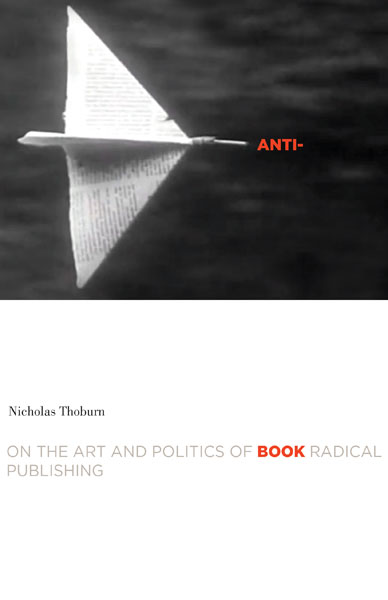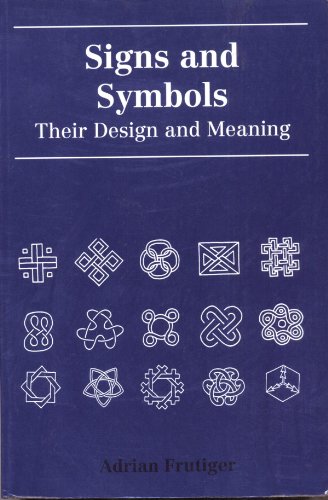Nicholas Thoburn: Anti-Book: On the Art and Politics of Radical Publishing (2014–) [EN, SC]
Filed under book | Tags: · alternative media, artists book, literary criticism, magazine, mass media, politics, print, publishing

“No, Anti-Book is not a book about books. Not exactly. And yet it is a must for anyone interested in the future of the book. Presenting what he terms “a communism of textual matter,” Nicholas Thoburn explores the encounter between political thought and experimental writing and publishing, shifting the politics of text from an exclusive concern with content and meaning to the media forms and social relations by which text is produced and consumed. Taking a “post-digital” approach in considering a wide array of textual media forms, Thoburn invites us to challenge the commodity form of books—to stop imagining books as transcendent intellectual, moral, and aesthetic goods unsullied by commerce. His critique is, instead, one immersed in the many materialities of text.
Anti-Book engages with an array of writing and publishing projects, including Antonin Artaud’s paper gris-gris, Valerie Solanas’s SCUM Manifesto, Guy Debord’s sandpaper-bound Mémoires, the collective novelist Wu Ming, and the digital/print hybrid of Mute magazine. Empirically grounded, it is also a major achievement in expressing a political philosophy of writing and publishing, where the materiality of text is interlaced with conceptual production. Each chapter investigates a different form of textual media in concert with a particular concept: the small-press pamphlet as “communist object,” the magazine as “diagrammatic publishing,” political books in the modes of “root” and “rhizome,” the “multiple single” of anonymous authorship, and myth as “unidentified narrative object.””
Publisher University of Minnesota Press, 2016
Cultural Critique Books series
ISBN 9780816621965, 0816621969
xvi+372 pages
Interview with author: Ron Hanson (White Fungus, 2020).
Reviews: Filipe Carreira da Silva (Contemporary Political Theory, 2017), Anthony Iles (Mute, 2018), Samuel A. Moore (Cultural Studies, 2018), Ola Ståhl (Parallax, 2018), Nick Thurston (Comparative Critical Studies, 2019), Martin Paul Eve (American Literature, 2019), Terrine M. Friday (Canadian Journal of Communication, 2019), Simone Murray (Left History, 2019).
Publisher (EN)
Publisher (SC)
WorldCat (EN)
Anti-knjiga: Materijalni tekst i političko izdavaštvo (Serbo-Croatian, 2014, 1 MB, added on 2017-5-2)
Anti-Book: On the Art and Politics of Radical Publishing (English, 2016, HTML; PDF, updated on 2019-7-2)
Adrian Frutiger: Signs and Symbols: Their Design and Meaning (1978–) [EN, FR, BR-PT]
Filed under book | Tags: · design, graphic design, ornament, print, sign, text, typography, writing

“Universally-recognized signs and symbols have always been among the most important elements of communication. By why is it that certain configurations of dot and line, and certain primary shapes, are perceived and remembered more easily than others? Taking the six faces of dice as his starting point, Frutiger writes about signs and symbols in general and the development of writing in particular. Throughout, he relates the basic principles and components of graphics to a wide range of historical, physical, linguistic and practical considerations. He embraces everything from Egyptian hieroglyphics to modern company logos in his intriguing analysis of the way that humans have always tried to express thought and communication through graphic means. This standard work is aimed at all those concerned with graphics, design, ornament and communication in general.”
Originally published as Der Mensch und seine Zeichen, 3 vols., Weiss Verlag, Dreieich, 1978-81.
English edition
Translated by Andrew Bluhm
Publisher Van Nostrand Reinhold, New York, 1989
ISBN 0442239181
360 pages
WorldCat (EN)
Signs and Symbols: Their Design and Meaning (English, trans. Andrew Bluhm, 1989, low res, 39 MB)
L’Homme et ses signes: signes, symboles, signaux (French, trans. Danielle Perret, 2nd ed., 1999/2014, 5 MB)
Sinais e símbolos: desenho, projeto e significado (BR-Portuguese, trans. Karina Jannini, 2nd ed., 1999/2007, 59 MB, added 2016-8-3)
See also Frutiger’s Type Sign Symbol, 1980.
Comment (1)I Think That Conversations Are the Best, Biggest Thing That Software Has to Offer its User (2015)
Filed under book | Tags: · art, collaboration, design, floss, free software, graphic design, libre graphics, peer production, print, software, standards, typography

“I think that conversations are the best, biggest thing that free software has to offer its user.
An extensive collection of conversations between developers and designers involved in the wider ecosystem of Libre Graphics. Speaking to each other about tools for typography, lay-out and image processing they render a portrait of a community gradually understanding the interdependencies between Free Software and design. Conversations is edited by Femke Snelting in collaboration with Christoph Haag.”
In conversation with: Agnes Bewer, Alexandre Leray, An Mertens, Andreas Vox, Asheesh Laroia, Carla Boserman, Christina Clar, Chris Lilley, Christoph Haag, Claire Williams, Cornelia Sollfrank, Dave Crossland, Dmytry Kleiner, Denis Jacquery, Dmytri Kleiner, Eleanor Greenhalgh, Eric Schrijver, Evan Roth, Femke Snelting, Franziska Kleiner, George Williams, Gijs de Heij, Harrisson, Ivan Monroy Lopez, John Haltiwanger, John Colenbrander, Juliane De Moerlooze, Julien Deswaef, Larisa Blazic, Ludivine Loiseau, Manuel Schmalstieg, Matthew Fuller, Michael Murtaugh, Michael Terry, Michele Walther, Miguel Arana Catania, momo3010, Nicolas Malevé, Pedro Amado, Peter Westenberg, Pierre Huyghebaert, Pierre Marchand, Sarah Magnan, Stéphanie Vilayphiou, Tom Lechner, Urantsetseg Ulziikhuu, Xavier Klein.
Concept, development and design by Christoph Haag, Xavier Klein, and Femke Snelting
Edited by Thomas Buxó, Loraine Furter, Maryl Genc, Pierre Huyghebaert, and Martino Morandi
Publisher Constant, Brussels, January 2015
Free Art License 1.3
ISBN 9789081145930
351 pages
PDF, PDF (30 MB, updated on 2018-6-20)
Git

